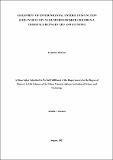| dc.description.abstract | Undernutrition affects 20% of children under five in the developing world. Stunting is a
prevalent form of undernutrition. Global prevalence of stunting in 2019 was 21.4%, while
current Tanzania national average is 34%. Ruvuma is one of the regions with highest
prevalence of stunting (44%) in Tanzania. This dissertation involved studies on factors
responsible for the high prevalence of stunting in Ruvuma and their association with
environmental enteric dysfunction (EED) in children. The study included randomly and
conveniently sampled children below 5 years of age between April 2019 – January 2020 who
attended outpatient clinics at hospitals in Ruvuma. Among children in the cross-sectional
survey, 46% were females and 45.6% were stunted, while the case-control study had 42%
females, 78% stunted cases, and EED prevalence of 57%. Through bivariate analysis, stunting
was associated with gender (χ2 = 6.6759, df = 1, p = 0.009772), hand washing before food (χ2
=
5.1213, df = 1, p = 0.02363), location of hospital (χ2 = 3.851, df = 1, p = 0.04972) and use of
Municipal garbage collection system (χ2 = 3.6814, df = 1, p = 0.05502). Moreover, diarrhea
was associated with toilet sharing (χ2 = 5.4703, df = 1, p = 0.002), use of household’s toilet (χ2
= 4.0224, df = 1, p = 0.004) and rinsing child feces into toilet (χ2 = 3.6814, df = 1, p < 0.01).
Multivariate logistic regression analyses showed that, stunting risk increased with male gender
(OR (95%CI) = 1.7945 (1.1944 –2.712), age (OR (95%CI) = 1.3122 (1.1484 –1.507), and
decreased with hand washing before meal (OR (95%CI) = 0.5403 (0.3042 –0.940). Finally,
diarrhea risk increased with toilet sharing (OR (95%CI) = 2.154 (1.153 –3.953) and decreased
with child’s use of toilet (OR (95%CI) = 0.510 (0.259 –0.945). Our study generally revealed
important factors that determined observed high prevalence of stunting in Ruvuma. These
factors can be modified through health interventions to reduce the observed high prevalence.
Nevertheless, the association between EED and stunting is undeniable and needs further
assessment in a bigger study. | en_US |

